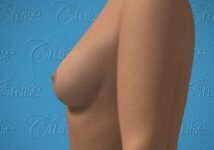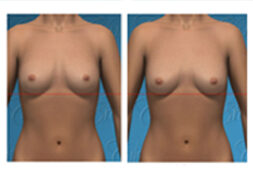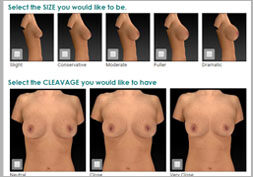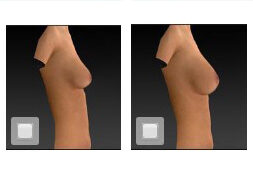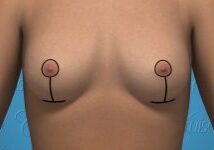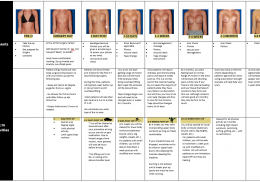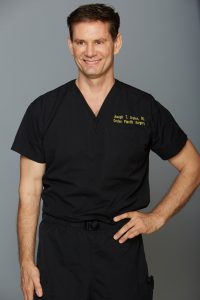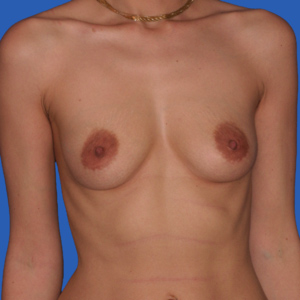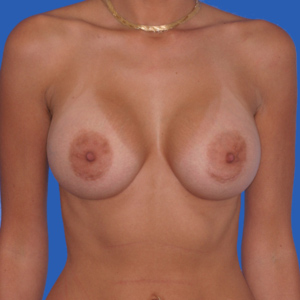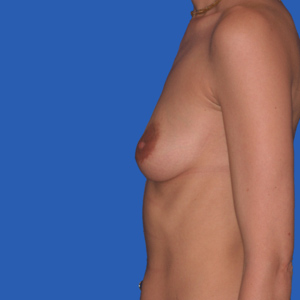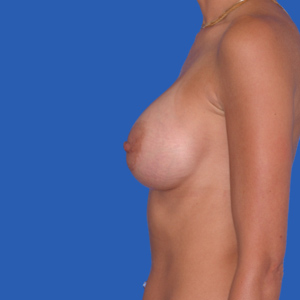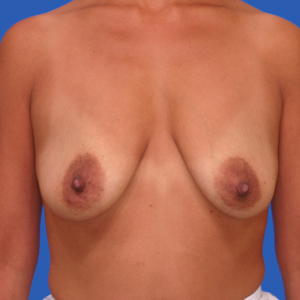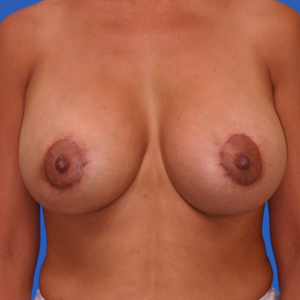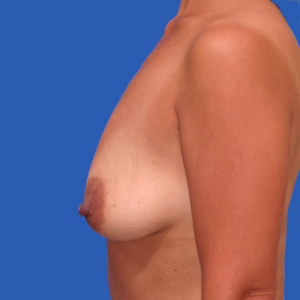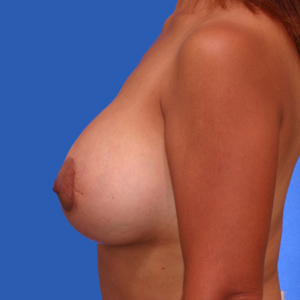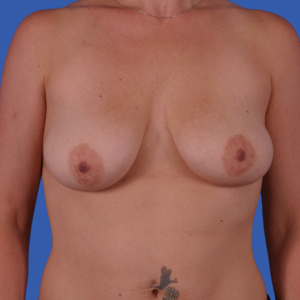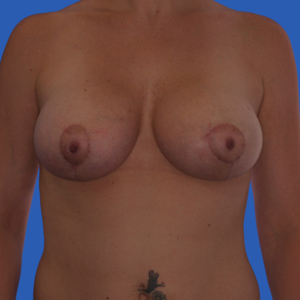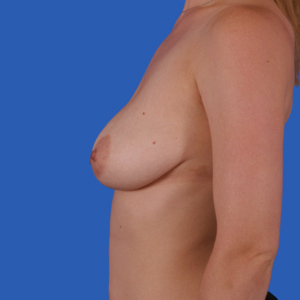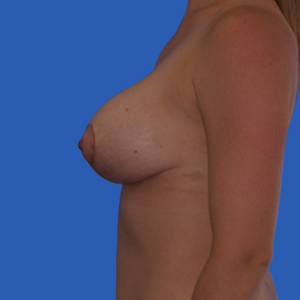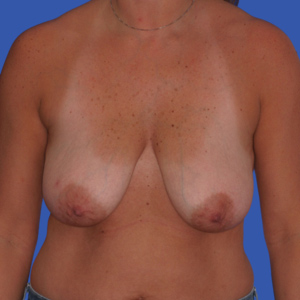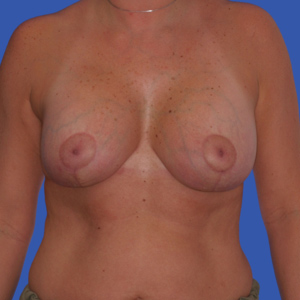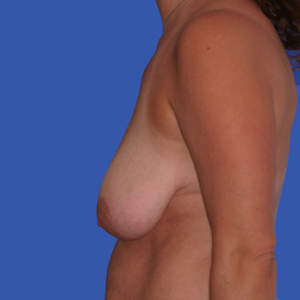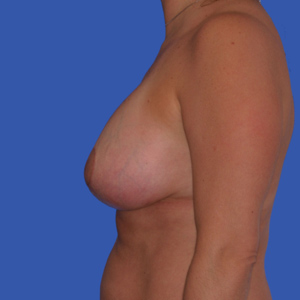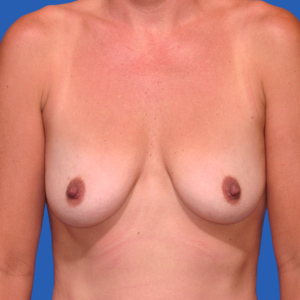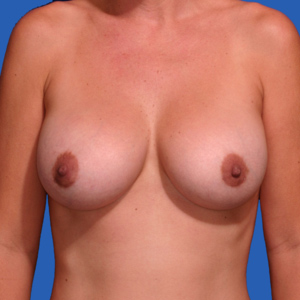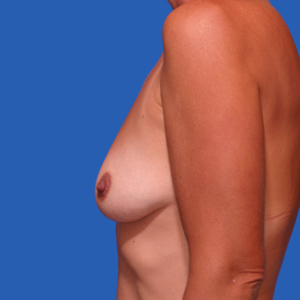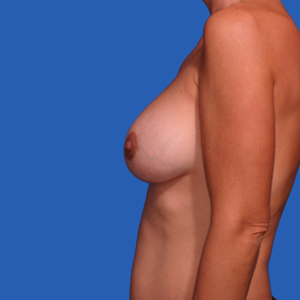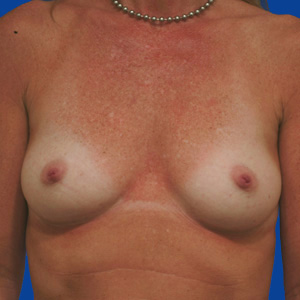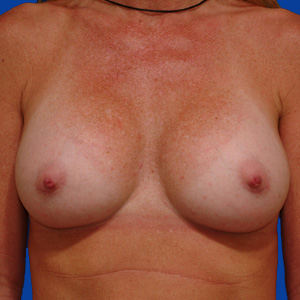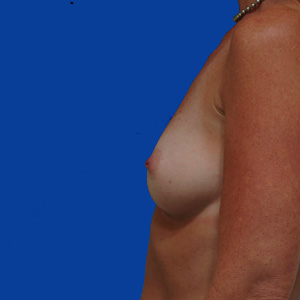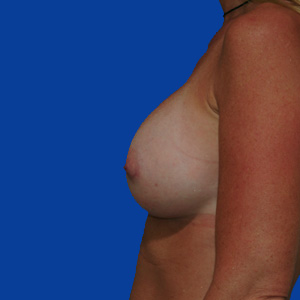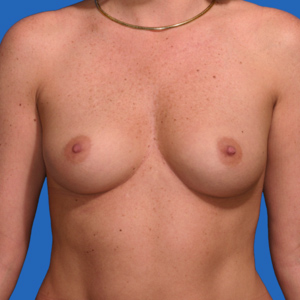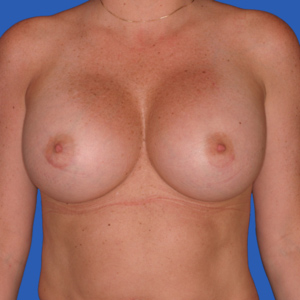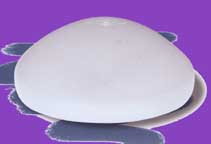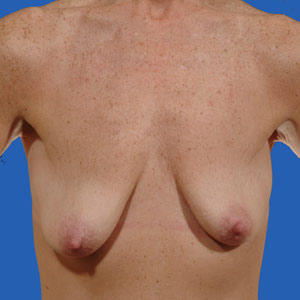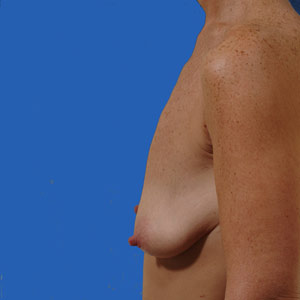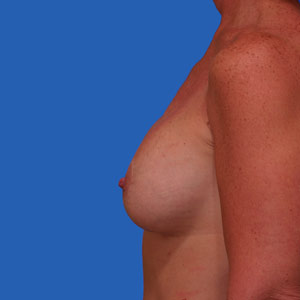Breast Lift Dr Cruises Philosophy
Dr. Cruise's Breast Lift Philosophy
Breast lifting with or without augmentation has become very popular across the United States and especially here in Orange County. This is because many women are no longer willing to accept sagging, deflated breasts as just a necessary consequence of aging and/or child birth.
A good part of my practice is devoted to understanding the physical and emotional issues these women have concerning their breasts. Typically, these women are healthy and well adjusted. Their self esteem, however, has been deflated because their once youthful, perky breasts are now hanging at a level that makes them feel older than they really are. These women want to feel attractive again.They want to be able to wear stylish, sexy clothes. Finally, they are tired of wearing special bras that do not seem to create the look they are hoping to achieve.
Breast lifting with augmentation is a particularly complicated procedure. This is well recognized within the world of plastic surgery. This is because there are many variables involved. Many of the variables have conflicting effects on the results. On one hand, the lift component reduces the breast and removes sagging volume. On the other hand, the breast implant component augments the breasts and adds lifting volume. For this reason, with breast lift it is particularly important for you to find a plastic surgeon who has considerable experience and the desire to find out exactly what you want.
In my practice, I have gone through an evolution of technique. The reason is because I was never happy with the common way of performing breast lifts. Common plastic surgery techniques attempt to lift breast tissue back into it's previous position. I spent the early part of my career doing it this way but was often disappointed as the natural breast tissue would succumb to gravity and sag again. In addition, the shape of the lower part of the breast was never round like that of the youthful breast. Instead, it took on a more flat, rectangular, hanging appearance that still had an aged, deflated appearance.
After analyzing these breasts I decided that the breast tissue that hangs below the breast will never be attractive and will always return to its sagging position. Therefore, my current technique is to remove the tissue that sags below the level of the breast fold. Then gather the breast tissue in from the sides. This eliminates the hanging, rectangular breast appearance and creates a full, round appearance like that seen in the youthful breast. Finally, when all the breast tissue is in correct position and the round shape has been created, I will often add an implant to restore upper breast fullness and cleavage.
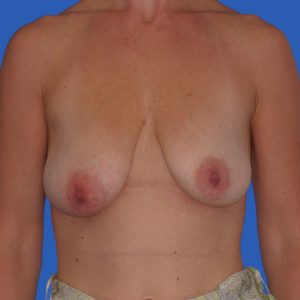
Before
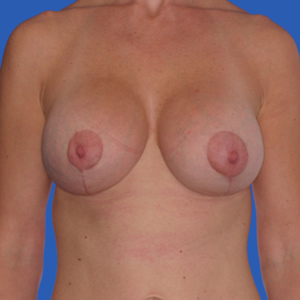
After
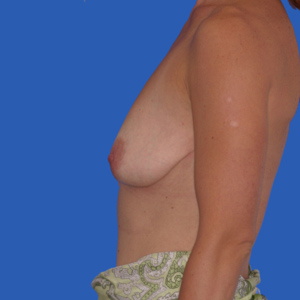
Before
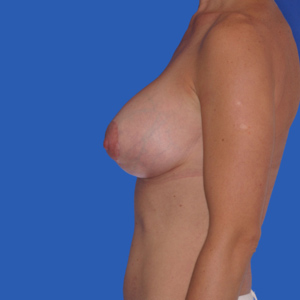
After
Breast Lift Anchor with augmentation- Silicone Breast Implant 350cc Moderate Plus Profile - Mentor. Three months post-op. Patient 35-year-old.
A by-product of this technique is that I am able to substantially reduce the length of the incision. In fact, my incisions never travel anywhere near the midline or the outside part of the breast. The horizontal incision remains hidden below the breast. This allows my patients to wear bikinis or any low cut dress they chose without any concern of the scar being visible. Some even elect to not wear a bra at all - something that was not even remotely a consideration prior to the breast lift. Although this is possible, it is recommended to wear support most of the time. Having said all that you must keep in mind that incisions are necessary and will never go away completely.
It is extremely important to find out exactly what the patient wants to obtain as far as breast lifting goes. Some women are only concerned with correcting the sagginess while others are more concerned with cleavage and fullness in the upper breast. It is important to be able to predict both breast size and shape after the breast lift. Some women want a fuller look, therefore, are best served by adding an implant in addition to the breast lift. This is all personal preference, but it is important to understand the desire of each patient so that the procedure can be tailored to her particular needs.
During your plastic surgery consultation, it is very important that you and your plastic surgeon understand exactly what you want to accomplish. I will walk you through my thought process that I go through during every one of my consultations. Different surgeons, of course, will have different methods. No matter how it is done, at the end of your consultation, you must feel that your plastic surgeon clearly understands the look you are after.
Below I'll discuss the following:
- Incisions
- Implant or no implant
- Implant size
- Shape of implant
- Implant profile
- Silicone implant vs. saline implant
- Implant placement (above or below the muscle)
- Asymmetry
- Excess fat near arm pits and lateral breast roll
1. Incisions
Incisions are perhaps the biggest concern that my patients have. They have seen or heard of horror stories of breast lifting gone wrong leaving the patient with significant scarring. It is important to understand that plastic surgeons do not control how an individual patient scars. Some patients scar worse than others. Plastic surgeons can, however, control the placement and precision of the scar. This is part of the artistry of plastic surgery.
I understand your concern about putting scars on your breast. I take this into consideration as we decide together what is best for you. The truth is, if you have significant sag, a proper breast lift with augmentation is far superior to an augmentation alone. In fact, an augmentation alone may give you a very elongated, older appearing breast. This has been given the nickname "rock in a sock" look. What we are looking for is a lifted, round appearance seen in a youthful breast.
Patient treated with breast augmentation alone who really needed breast augmentation in conjunction with breast lift. The surgeon placed the implants very low to avoid lift. In reality this created a very elongated, older appearance of the breast and significantly shorter abdomen.
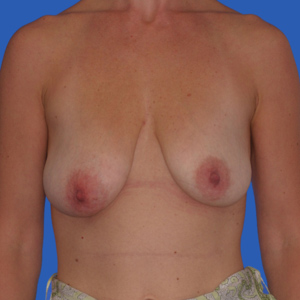
Before
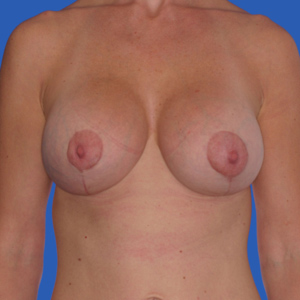
After
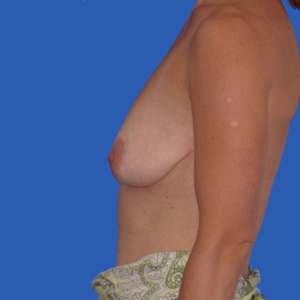
Before
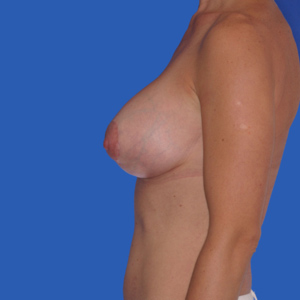
After
The same patient after anchor breast lift, elevation of inframammary fold and changing implant to a smaller size. Notice the upper fullness, improved cleavage and longer torso.
In the example above if the surgeon did not place the implant low it would have created a "double bubble" appearance. When a lift is necessary a breast augmentation alone is not going to provide you with the look you want.
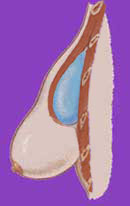
"Double Bubble" (also known as "Snoopy Dog Deformity") Example of breast that needed a breast lift with augmentation but was treated with augmentation alone. This is different than the "rock in the sock" appearance because the implant was placed in the normal position not in a lower position.
The most important thing is, and I can not stress this enough; find a plastic surgeon with considerable experience with this procedure. Breast lifting with augmentation is very challenging as there are many variables going on all at once.
When evaluating sag, the entire breast along with patients wishes need to be taken into consideration. To make things as simple as possible, I will discuss the two most important considerations. They are not absolute measurements. These are:
- The relationship of the nipple to the Infra-mammary Fold (IMF)
- The relationship of the bottom of the breast to the IMF. Other factors, of course, will need to be discussed at the time of consultation
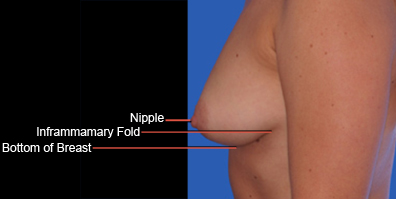
Before we get started, it is important to point out that breasts with more natural breast tissue are more likely to need a lift. This is because the bottom of the breast will continue to fall. To remedy this, removing this breast tissue with a lift will correct the sag and actually decrease the chance of sag in the future.
Another consideration is the size of the implant. A bigger implant will provided more lift. This makes sense as more volume will fill the excess skin envelop more adequately. Of course, you should not go with a larger implant for this reason as the amount of lift that an implant can provide is limited.
Doing a breast lift alone rarely produces a great result as usually there is very little breast tissue in the upper chest. This can only be adequately treated by augmentation. Even patients with significant breast tissue usually benefit from the upper breast fullness created by an implant. In these cases, I usually will remove all the undesirable sagging breast tissue and put in a relatively small implant to create an attractive upper breast with cleavage.
There are four common breast lifts:
- Augmentation alone
- Donut lift
- Lollipop lift
- Anchor lift
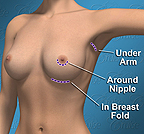
Common Breast Augmentation Incisions
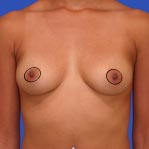
Peri-areolar Incision (Donut Lift).
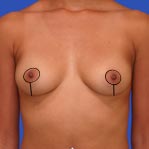
Peri-areolar Incision with Vertical Incision(Lollipop)
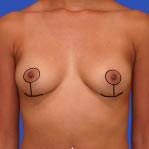
Peri-areolar Incision with Vertical and Horizontal Incision. (Anchor Lift)
Augmentation Alone
Once again, this will depend on the size of the implant. Usually, augmentation is all that is necessary when the nipple is above the level of the IMF and the bottom of the breast is no greater than 2 cm below the IMF. This is especially true when there is not much breast tissue. Heavier breasts require more to lift them.
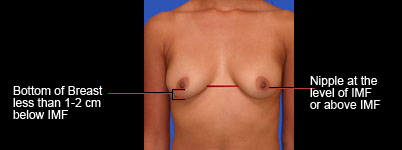
|
37 year old female with minimal breast sag corrected by breast implant alone. |
|
Donut Lift
The Donut lift is also known as the peri-areolar lift. It involves removing skin in the shape of a circle around the areola and placing a suture within this circle. This circular suture acts as a purse string to tighten this bigger circle into a smaller circle. This elevates the nipple into a higher position and tightens the skin envelope. The down-side of the Donut lift is that the purse string effect of the suture can flatten the breast. This is why an implant is highly recommended to combat this flattening.
One misnomer is that the Donut lift is more of a nipple lift than a breast lift. This is because it does not really lift sagging breast tissue that has dropped more than 2 cm below the IMF. It does however, elevate the nipple. It is ideal for the breast that has minimal sag and not much tissue.
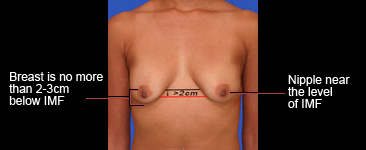
|
34 year old woman with minimal breast sag corrected by breast augmentation and Donut breast lift. |
|
Lollipop Breast Lift
This type of breast lift involves an incision around the areola and straight down the bottom of the breast. Patients often do not want this lift because they do not want the vertical incision. This incision, if properly placed by an experienced plastic surgeon, is quite acceptable. Truth is, if it is necessary, it is a far better procedure than the donut lift as it actually removes the hanging breast tissue. Further sag in the future is dramatically reduced or prevented.
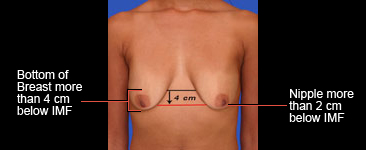
This woman has nipple descent 4 cm below the IMF and breast descent 5 cm below IMF. She will most likely need a breast augmentation with Lollipop breast lift.
28 year-old female with some breast sag corrected by lollipop breast lift with 410cc implant.
Anchor Lift
The Anchor lift is quite similar to the Lollipop lift except that it has an additional incision that falls within the IMF. This extra incision is necessary to remove excess skin from breast sag. The horizontal incision within the IMF is actually not visible in a standing position and is quite hard to see.
Candidates for the Anchor lift are women whose breast tissue falls significantly below the IMF. Whether, or not, this horizontal skin removal is necessary depends on many things. If the bottom of your breast is greater than 6 cm below the IMF a horizontal incision will usually be necessary.
The length of the horizontal incision depends on how far the bottom of the breast falls. For example, a breast 10 cm below the IMF will need a longer horizontal incision than one with 6 cm below the IMF.

This woman has nipple descent greater than 4 cm below the IMF and breast descent greater than 6 cm below the IMF. She, most likely, will need an Anchor lift.
|
38 year-old patient who had significant descent. Breast sag was corrected with anchor breast lift and augmentation with 295cc saline implant. |
|
2. Implant or No Implant
Breast Lifting does a wonderful job of lifting breast tissue that has fallen below the level of the IMF. It does not, however, do a good job of creating upper breast fullness and cleavage. This is why I strongly recommend using an implant to accomplish what the lift alone cannot. While I still do breast lifts alone, the result is compromised. Fortunately, most women in Southern California are willing to accept an implant in return for an improved result.
If you are considering a lift without an implant you can always add the implant later. Some surgeons actually prefer this way as it does make the procedure easier. I will recommend a two stage approach if the nipples have fallen greater than 10 cm below the IMF. This is because when the nipple is elevated greater than 10 cm there is a risk of loss of blood supply to the nipple.
Once the decision is made to add an implant the next choice is to decide on which implant is best. There are several characteristics to breast implants that need to be considered; size, shape, and saline vs silicone. Lets go over each individually.
3. Implant Size
Deciding on an implant size for a breast lift is somewhat different than that for a straight forward breast augmentation. It requires a bit more three dimensional thinking as you have to consider the breast tissue already present. Taking it one step further, you have to consider how the breast size and shape changes as the sagging breast tissue is elevated into position.
With breast augmentation we utilize bra sizing to determine implant size. With breast lifting, this can not be done so easily. This is because the elevation of breast tissue changes the breast size and shape. When only a Donut lift is necessary we still perform bra sizing as it is still quite accurate. With both the Lollipop lift and the Anchor lift there is too much change in breast tissue to allow bra sizing to be accurate.
The entire scope of this topic can not be covered here. This is part of the artistry of plastic surgery. One thing to consider is that the breast skin has already shown that it has a tendency to sag. Therefore, it is wise not to go too large as it will stretch the skin further.
On the other hand, the implant should be large enough to give fullness to the upper pole of the breast and to create cleavage. There are too many variables to factor in, therefore, exact sizing in breast lifts can only be done during consultation.
4. Shape of Implant
Implant shape is discussed extensively within the Breast Augmentation section. Many of the concepts discussed there are valid and, therefore, are worthwhile going over. What we will then consider is how these different shapes apply to breast lifting. As I mentioned earlier, the complexity level increases with breast lifting because of the added variables.
During my consultation, I ask all my patients what shape do we want to achieve in the upper part of the breast. I divide it into three options:
- Natural
- "California Natural"
- Dramatic
Natural
Natural means a straight or even a slightly concave upper part of the breast. This is what you would find in a youthful, non-augmented breast. It is full, but does not look like it has been augmented. It is ideal for someone who does not want anyone to know she has been augmented but still wants to have a sexy, more proportionate shape to her breasts.
|
Patient 5'10", 150lb - went from 36B to 36C/D. Saline Implant 440-460cc Low Profile filled to 460cc. Implants were placed under the muscle. Notice the gentle slope of the upper breast despite using a large implant. |
|
"California Natural"
I coined the term "California Natural" to describe women who want to have full upper breasts slightly rounder than natural but do not want to be too dramatic. Before I created this intermediary category, these woman would say they wanted to be "natural." Living in California, our perception of "natural" is slightly skewed to a fuller look than what natural really is. These women want a slightly rounded shape to the upper breast without a "shelfy" look. The "California Natural" breast has a slight convexity to it. It can look very natural in loose clothing but can look dramatic in a push up bra.
|
Patient 5'4", 120lb - went from 32A to 34C. Saline Implant 330-360 Moderate Profile was filled to 345cc, placed under the muscle. Notice the slightly rounded upper part of the breast. |
|
Dramatic
Dramatic speaks for itself. These woman want significant projection of the breast. This will create a dramatic look even without a bra to push it up.
|
Patient 5'6", 140lb, went from 34B to 36DD. Saline Implants 510-540 Moderate Profile were filled to 550cc, placed under the muscle. Notice the rounded appearance of the upper part of the breast. |
|
Now that we have defined shape, as it relates to breast augmentation, lets apply it to breast lifting. The most important factor is to make sure that the implant diameter fits the chest wall and the newly elevated breast tissue. This takes us into our next topic for consideration - Profile.
5. Implant Profile
I purposely placed profile directly under shape because profile has a significant effect on shape. There are three different types of profiles; low, moderate and high.

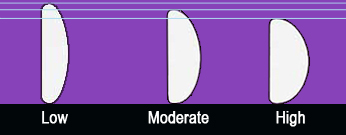
Their is a difference in shape between saline and silicone. For a given volume, silicone will have a more natural shape in the upper breast. For this reason, saline implants tend to look bigger even though the volume is the same. This can be minimized by not filling the saline implants to the top of their fill volume. This gives a more natural appearance. Under filling too much, however, increases the risk of rippling.
My philosophy with profile and shape is quite different between breast augmentation and breast lift. With my technique of Anchor and Lollipop breast lifting I am able to create a significant amount of breast projection. Therefore, what I really need from the implant is to provide a wide base to improve upper breast fullness and create cleavage. For this reason, I often will choose a low or "natural" profile implant. I do not need projection as I can create my own naturally.
If you have very little natural breast tissue and have mostly hanging skin with little volume then projection from the implant becomes more important. In this case a moderate profile silicone may be more appropriate. This is particularly true for Donut lifts which tend to flatten the breast out slightly. To combat this a moderate or possibly a high profile implant may be desirable.
6. Silicone Implants Vs. Saline Implants
Silicone vs saline implants is further defined within the Breast Augmentation section.
This is usually a decision I leave up to patient. I merely provide the facts. The facts are - both implants can provide a great result. Many plastic surgeons strongly recommend silicone because it has a lower rate of rippling. This is not so true in my practice as rippling is not very common. I believe this is because I put the implant under both the pectoralis minor and pectoralis major muscle.
|
|
Simply put; silicone implants have a more natural feel. So I tell my patients, "If a natural feel is very important to you, go with the silicone." Another advantage of silicone is that it produces a more natural appearance to the upper part of the breast. Some people want this natural look others want a more full look, i.e. "California Natural."
The major advantage of saline is that if it ever ruptures the saline simply gets flushed out of the body. Silicone, on the other hand, will stay in place. Sometimes, it is hard to tell if a silicone implant has ruptured as it maintains its shape relatively well.
You can achieve good results with either implant with a breast lift. I recommend silicone to women who have very little natural breast tissue. In these women the silicone implants have a better feel and more natural look. In women with a significant amount of breast tissue the difference between silicone and saline becomes less important.
In summary, go with silicone implants if you want the most natural feel and the most natural shape. Go with saline implants if you are concerned about the effects of silicone gel.
7. Implant Placement (Above or Below the Muscle)
Lets first define what we mean by above or below the muscle. The muscle we are talking about is the Pectoralis Major muscle. It runs diagonally from the chest to the shoulder.
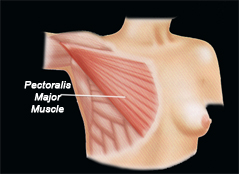
Pectoralis Major Muscle - runs across the chest diagonally to the shoulder.
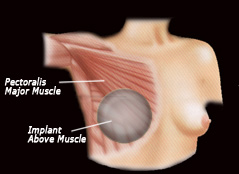
Breast Implant Above the Pectoralis Major Muscle.
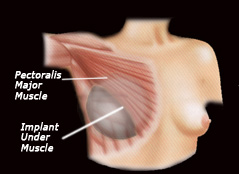
Breast Implant Under Pectoralis Major Muscle.
Good results can be obtained above or below the pectoralis major muscle. I strongly believe, however, that under the muscle provides the best results for several reasons. The most important reason is that it lowers the chance of capsular contracture or "hardening of the implant." The muscle acts as a constant massager of the implant - helping to keep it soft. From an aesthetic standpoint, it has several advantages. It acts as a buffer giving an added layer of implant coverage. This is especially helpful in the upper part of the breast. The muscle diffuses the implant over a greater area preventing a "shelfy" and overly round appearance. This is particularly important with a breast lift as we want to create more upper breast fullness and cleavage. In addition, placing the implant under the muscle significantly decreases the chance of rippling except along the lateral part of the breast where the pectoralis major muscle does not exist.

Implant Under Pectoralis Major Muscle. Notice how the lower lateral portion of the implant is not covered by muscle.
As you can see, the entire lateral part of the implant is uncovered even when the implant is placed under the muscle. To provide better coverage, I have developed a unique way of putting the implant under another muscle along the lateral chest wall to almost completely cover the entire implant. This muscle is called the serratus anterior. This is why, I believe, my saline implants rarely have any rippling.
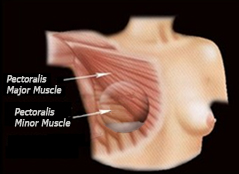
Implant Covered by Both Pectoralis Major and Serratus Muscles.
In addition to providing valuable coverage, the Serratus Anterior also prevents the implant from migrating into the arm pit. Furthermore, this muscle pushes the implant toward the midline giving enhanced cleavage. Think of it a a book shelf preventing the implants from sliding outward.
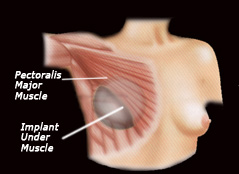
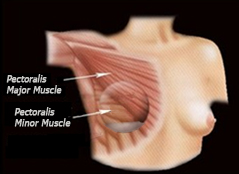
Serratus Anterior Muscle Pushes the Implant Toward the Midline.
8. Asymmetry
Asymmetry is important to point out as virtually every woman considering mastopexy has some degree of it. The key is to determine what is causing the asymmetry and correct it as much as possible. Complete correction of asymmetry is not possible. The key is to place the nipples at the same level and create similar breast shape.
With breast lifting one breast is always larger than the other. This means that one side will need more skin and tissue removal. The goal is to remove the correct amount so that symmetry is as close a possible.
Minor to moderate differences in breast volume are usually not noticeable once the breast has been augmented and lifted. In fact, I try not to use different sized implants as this can actually create asymmetry especially within the upper breast. The reason for this is that putting a bigger implant in the smaller breast may improve the volume asymmetry but will create breasts with two different shapes. For this reason I much prefer to remove more tissue from the larger breast and put in a slightly larger implant into both breasts. With this technique I am best able to create close symmetry with both size and shape.
|
Correction of significant breast sag and asymmetry achieved through breast lift and enlargement. Breast Lift and Augmentation - After picture shows improvement of breast fullness. Two years postop. Patient 47-y-o. |
|
9. Excess Fat near Arm Pits or Lateral Breast Roll.
Fat deposits around the breast are important to discuss during consultation as they have a big impact on the overall look. The two most common areas that are a problem are the axilla and the lateral breast roll. Liposuction of these two areas can easily be done at the same time as breast lift with augmentation. I must warn you that concomitant liposuction will make the breasts bruise and swell more than breast augmentation alone. It is certainly worth as most women who have these two fat deposits have grown to really despise them.
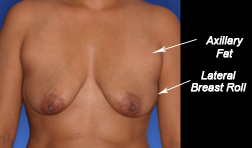
The two most common fatty deposits that often need to be addressed with breast lifting are the axillary fat and the lateral breast roll fat.
Examining these areas shows that the plastic surgeon is looking at the entire breast area and not just the breast itself. If these areas bother you, be sure to point them out to your plastic surgeon if he/she does not do so.
I know this is a tremendous amount of information but, believe it or not, I condensed it down the best I could. I know this information is important to you. It always surprises me how much my patients understand as long as the information is presented to them in a easy to understand fashion that makes sense.
It is your job to understand the material the best you can. It is my job to understand the fine nuances that go far beyond the scope of this presentation. This is where the art and science of plastic surgery come together and make it all worth while.
Breast Lift / Mastopexy Information Resource for Southern California including Orange County, Newport Beach, Los Angeles, San Diego, and Beverly Hills.

